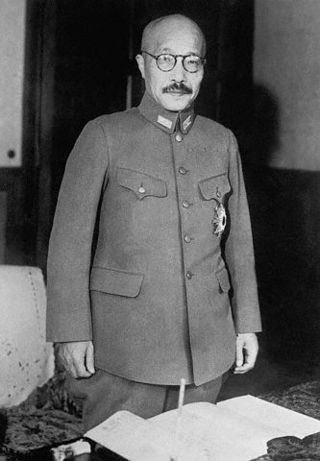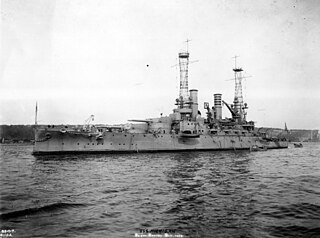
Theodore Roosevelt Jr., often referred to as Teddy or by his initials, T. R., was an American politician, statesman, conservationist, naturalist, and writer who served as the 26th president of the United States from 1901 to 1909. He previously held various positions in New York politics, rising up the ranks to serve as the state's 33rd governor for two years. He later served as the 25th vice president under President William McKinley for six months in 1901, assuming the presidency after McKinley's assassination. As president, Roosevelt emerged as a leader of the Republican Party and became a driving force for anti-trust and Progressive policies.

The Great White Fleet was the popular nickname for the group of United States Navy battleships that completed a journey around the globe from December 16, 1907, to February 22, 1909, by order of President Theodore Roosevelt. It consisted of 16 battleships divided into two squadrons, along with various small escorts, and earned its moniker for the stark white paint on its hulls.

Big stick ideology, big stick diplomacy, big stick philosophy, or big stick policy was a political approach used by the 26th president of the United States, Theodore Roosevelt. The terms are derived from an aphorism which Roosevelt often said: "speak softly and carry a big stick; you will go far". The American press during his time, as well as many modern historians today, used the term "big stick" to describe the foreign policy positions during his administration. Roosevelt described his style of foreign policy as "the exercise of intelligent forethought and of decisive action sufficiently far in advance of any likely crisis". As practiced by Roosevelt, big stick diplomacy had five components. First, it was essential to possess serious military capability that would force the adversary to pay close attention. At the time that meant a world-class navy; Roosevelt never had a large army at his disposal. The other qualities were to act justly toward other nations, never to bluff, to strike only when prepared to strike hard, and to be willing to allow the adversary to save face in defeat.

USS Louisiana (BB-19) was a Connecticut-class battleship of the United States Navy. She was the second member of the class of six pre-dreadnought battleships, and the third ship to carry her name. Louisiana was laid down in February 1903, launched in August 1904, and commissioned in June 1906. She was a 16,000-long-ton (16,000 t) battleship capable of 19 knots. Her main armament consisted of four 12-inch (305 mm) guns supported by a mixed secondary battery of 7 in (178 mm) and 8 in (203 mm) guns.

USS Maine (BB-10), the lead ship of her class of pre-dreadnought battleships, was the second ship of the United States Navy to be named in honor of the 23rd state. Maine was laid down in February 1899 at the William Cramp & Sons shipyard in Philadelphia. She was launched in July 1901 and commissioned into the fleet in December 1902. She was armed with a main battery of four 12-inch (305 mm) guns and could steam at a top speed of 18 knots.

USS Wisconsin (BB-9), an Illinois-class pre-dreadnought battleship, was the first ship of the United States Navy to be named for the 30th state. She was the third and final member of her class to be built. Her keel was laid down in February 1897 at the Union Iron Works in San Francisco, and she was launched in November 1898. The completed ship was commissioned into the fleet in February 1901. The ship was armed with a main battery of four 13-inch (330 mm) guns and she had a top speed of 16 knots.

USS Minnesota (BB-22), the fifth of six Connecticut-class pre-dreadnought battleships, was the first ship of the United States Navy in honor of the 32nd state. She was laid down at the Newport News Shipbuilding Company of Newport News, Virginia in October 1903, launched in April 1905, and commissioned into the US fleet in March 1907, just four months after the revolutionary British battleship HMS Dreadnought entered service. Minnesota was armed with a main battery of four 12-inch (305 mm) guns and a secondary battery of twenty 7 and 8 in guns, unlike Dreadnought, which carried an all-big-gun armament that rendered ships like Minnesota obsolescent.

Robley Dunglison Evans, born in Floyd County, Virginia, was a rear admiral in the United States Navy, who served from the American Civil War to the Spanish–American War. In 1907–1908, he commanded the Great White Fleet on its worldwide cruise from the Atlantic Ocean through the Straits of Magellan to the Pacific Ocean.

Theodore Roosevelt V, also called Theodore IV, is an American investment banker and managing director at Barclays Investment Bank. He is a member of the Council on Foreign Relations, the Economic Club of New York, and the Foreign Policy Association, and serves on the Advisory Council of Represent.Us, a nonpartisan anti-corruption organization. Roosevelt is also a prominent conservationist. His name suffix varies since his great-grandfather, President Theodore Roosevelt, was a son of Theodore Roosevelt Sr., though the same-named son did not commonly use a "Jr." name suffix.

William Sheffield Cowles was a rear admiral in the United States Navy.
The Square Deal was Theodore Roosevelt's domestic program, which reflected his three major goals: conservation of natural resources, corporate law, and consumer protection.
The Root–Takahira Agreementwas a major 1908 agreement between the United States and the Empire of Japan that was negotiated between United States Secretary of State Elihu Root and Japanese Ambassador to the United States Takahira Kogorō. It was a statement of longstanding policies held by both nations, much like the Taft–Katsura Agreement of 1905. Both agreements acknowledged key overseas territories controlled by each nation. Neither agreement was a treaty and no Senate approval was needed.

The presidency of Theodore Roosevelt started on September 14, 1901, when Theodore Roosevelt became the 26th president of the United States upon the assassination of President William McKinley, and ended on March 4, 1909. Roosevelt had been the vice president for only 194 days when he succeeded to the presidency. A Republican, he ran for and won by a landslide a four-year term in 1904. He was succeeded by his protégé and chosen successor, William Howard Taft.

Japan's attack on Pearl Harbor took place on December 7, 1941. The United States military suffered 19 ships damaged or sunk, and 2,403 people were killed. Its most significant consequence was the entrance of the United States into World War II. The US had previously been officially neutral but subsequently entered the Pacific War, and after Italy's declaration of war and Germany's declaration of war shortly after the attack, the Battle of the Atlantic and the European theatre of war. Following the attack, the US interned 120,000 Japanese Americans, 11,000 German Americans, and 3,000 Italian Americans.

Two South Carolina-class battleships, also known as the Michigan class, were built for the United States Navy in the early twentieth century. Named South Carolina and Michigan, they were the first American dreadnoughts—powerful warships whose capabilities far outstripped those of the world's older battleships.
The 1906 State of the Union Address was written by Theodore Roosevelt, the 26th president of the United States, on Monday, December 3, 1906. He did not speak directly to the 59th United States Congress. He said, "The readiness and efficiency of both the Army and Navy in dealing with the recent sudden crisis in Cuba illustrate afresh their value to the Nation. This readiness and efficiency would have been very much less had it not been for the existence of the General Staff in the Army and the General Board in the Navy; both are essential to the proper development and use of our military forces afloat and ashore."
The 1901 State of the Union Address was given on Tuesday, December 3, 1901, by the 26th president of the United States, Theodore Roosevelt. It was presented to both houses of the 57th United States Congress, but he was not present. He stated, "The Congress assembles this year under the shadow of a great calamity. On the sixth of September, President McKinley was shot by an anarchist while attending the Pan-American Exposition at Buffalo, and died in that city on the fourteenth of that month." He concluded it with, "Indeed, from every quarter of the civilized world we received, at the time of the President's death, assurances of such grief and regard as to touch the hearts of our people. In the midst of our affliction we reverently thank the Almighty that we are at peace with the nations of mankind; and we firmly intend that our policy shall be such as to continue unbroken these international relations of mutual respect and good will."

John Henry Gibbons was a captain in the United States Navy. He was superintendent of the United States Naval Academy in Annapolis, Maryland, from May 11, 1911, to February 7, 1914. He was an 1879 graduate of the Naval Academy.
The presidency of Theodore Roosevelt began on September 14, 1901, when Theodore Roosevelt was inaugurated as the 26th president of the United States following the assassination of William McKinley, and it ended on March 4, 1909.

The severe acute respiratory syndrome coronavirus 2 (SARS-CoV-2), the cause of the COVID-19 pandemic, was detected on the aircraft carrier USS Theodore Roosevelt in March 2020 while she was at sea. Affected crew members were evacuated and the ship was ordered to Guam. The captain, Brett Crozier, wanted most of the crew to be removed from the ship to prevent the spread of the disease, but his superiors were reluctant. After several days Crozier e-mailed three of his superior officers and seven other Navy Captains, outlining a plan for the ship to be largely evacuated because the virus could not be contained on board. The letter leaked to the press, and the next day the Navy ordered most of the crew to be taken ashore, but the captain was relieved of command by Acting Secretary of the Navy Thomas Modly. Modly's order was controversial, and his later speech to the crew aboard Theodore Roosevelt was criticized. Modly resigned a few days later. By mid-April hundreds of crew members including Crozier had tested positive for the virus, and one had died.














